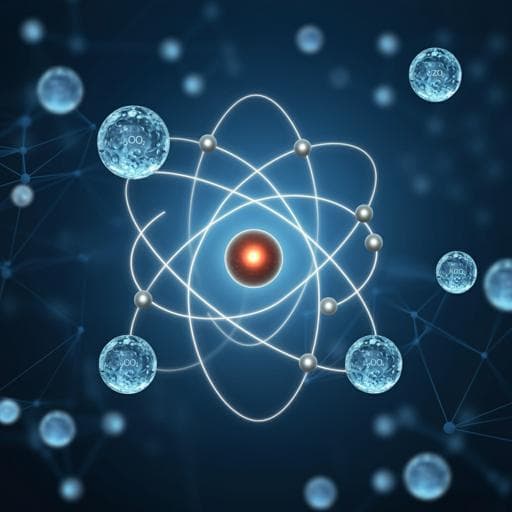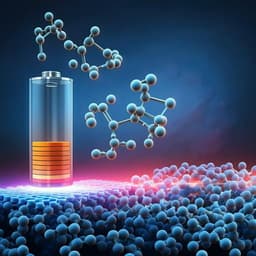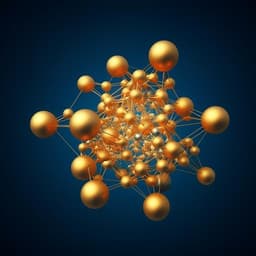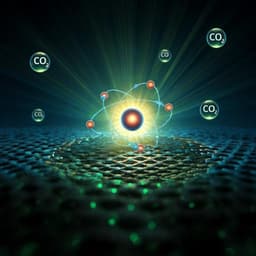
Chemistry
Electrochemical ammonia synthesis via nitrate reduction on Fe single atom catalyst
Z. Wu, M. Karamad, et al.
This groundbreaking research conducted by Zhen-Yu Wu and colleagues demonstrates a green approach for converting hazardous nitrate into valuable ammonia using an innovative Fe single atom catalyst. With an impressive ammonia Faradaic efficiency of ~75% and a yield rate of up to ~20,000 µg h⁻¹ mgcat⁻¹, this method stands as a promising alternative to traditional ammonia synthesis processes.
~3 min • Beginner • English
Introduction
The study addresses the need for sustainable ammonia synthesis by electrochemical routes. Conventional Haber–Bosch NH3 production operates at high temperature and pressure and consumes 1–2% of global energy, emitting ~1% of energy-related CO2. Electrochemical nitrogen reduction from N2 suffers from very low activity and selectivity due to the strong N≡N bond and challenges in excluding contamination at low NH3 rates. Nitrate (NO3−), an abundant water pollutant from industrial and agricultural sources, offers a more reactive nitrogen source for electrosynthesis of NH3 but competes with pathways to N2 and other intermediates. The research hypothesis is that isolating transition-metal active centers as single atoms will prevent N–N coupling steps leading to N2, thereby enhancing selectivity to NH3 during nitrate reduction. Inspired by Fe centers in Haber–Bosch catalysts and nitrogenase, the work proposes and tests Fe single-atom sites embedded in N-doped carbon (Fe–N4) as efficient, selective active sites for NO3−-to-NH3 conversion.
Literature Review
Prior work on electrochemical NH3 synthesis has focused on N2 reduction with limited rates and selectivity. For nitrate reduction, many metal catalysts (Ru, Rh, Ir, Pd, Pt, Cu, Ag, Au) and alloys have been developed to selectively convert nitrate to N2 with NH3 as a byproduct for water treatment. Mechanistic studies indicate complex multi-electron pathways with intermediates (NO2−, NO, N2O, NH2OH, etc.) and often significant hydrogen evolution. Descriptor-based analyses (e.g., N* and O* binding energies) have been proposed for transition metals. While single-atom catalysts (SACs) show unique activity/selectivity across reactions, transition-metal SACs had not been reported for electrocatalytic NO3−-to-NH3 conversion prior to this study. This work fills that gap and compares Fe SAC activity with Co and Ni SACs and Fe nanoparticles.
Methodology
Catalyst synthesis: Fe SAC prepared by transition-metal-assisted carbonization with SiO2 hard templates. Precursors (FeCl3, o-phenylenediamine, SiO2) were mixed in isopropanol, dried, pyrolyzed at 800 °C under Ar (2 h), then sequential NaOH and H2SO4 leaching to remove SiO2 and unstable species, followed by a second 800 °C anneal (2 h). Analogous syntheses yielded Co and Ni SACs (using CoCl2 or NiCl2·6H2O). N-doped carbon (NC) support and Fe nanoparticles on NC (FeNP/NC) were prepared for controls; FeNPs formed by NaBH4 reduction of FeSO4 on NC (22.2 wt% Fe). Characterization: TEM, MAADF-STEM, AC MAADF-STEM, EDS mapping, EELS point spectra, XRD, Raman, N2 sorption (BET and pore size), XPS (N 1s, Fe 2p), XAS (Fe K-edge XANES/EXAFS, wavelet transform; L-edge), ICP-OES for metal content and leaching. Electrochemistry: Customized H-cell with Nafion 117 separator, three-electrode setup (glassy carbon working electrode loaded with 0.4 mg cm−2 catalyst; SCE reference; Pt foil counter). Electrolyte typically 0.5 M KNO3 + 0.1 M K2SO4 (unless specified), Ar purged. LSV at 5 mV s−1; potentiostatic tests at set potentials for 0.5 h with 500 rpm stirring; IR compensation applied. Flow-cell tests used Fe SAC cathode and IrO2 anode with a bipolar membrane; anolyte 1.0 M KOH and catholyte 0.5 M KNO3/0.1 M K2SO4. Product quantification: NH3 by UV–Vis indophenol method (655 nm) with calibration; confirmation by 1H NMR (500 MHz) with DMSO-d6 and maleic acid internal standard; 15N isotope labeling (0.5 M K15NO3) to verify NH3 origin; NO2− quantified by colorimetry (540 nm); gaseous products (N2, H2) by GC. Faradaic efficiency and NH3 yield rate calculated from charge, concentration, volume, time, and catalyst mass. Stability: 20-cycle H-cell tests at −0.66 V (0.5 h each) and 35 h continuous flow-cell operation near −35 mA cm−2; post-mortem STEM/EELS/XAS. DFT calculations: QUANTUM ESPRESSO with PBE functional, ultrasoft pseudopotentials, graphene 5×5 supercell hosting Fe–N4 center, 4×4×1 k-point mesh, CHem computational hydrogen electrode approach; free energies include ZPE and entropic terms; 1.12 eV correction for HNO formation; explicit solvation check for NO*→HNO* step; limiting potentials derived from the largest uphill free-energy step. Comparative modeling on Fe(110), Co–N4, and Ni–N4.
Key Findings
- Fe SAC structure: Atomically dispersed Fe in N-doped carbon with Fe–N4 coordination (EXAFS dominant Fe–N peak at ~1.6 Å; no Fe–Fe features). Average Fe–N coordination number ~4; Fe–N bond length ~1.92 Å; Fe oxidation state between Fe0 and Fe3+ by XANES.
- Electrocatalytic performance in 0.5 M KNO3/0.1 M K2SO4 (H-cell): Onset at −0.50 V vs RHE with overall current density 4.3 mA cm−2, NH3 FE 39% and yield 331 µg h−1 mgcat−1. Max NH3 FE ~75% at −0.66 V (overall current 35.3 mA cm−2), yield 5245 µg h−1 mgcat−1. NH3 partial current density ~100 mA cm−2 at −0.85 V with yield ~20,000 µg h−1 mgcat−1. FE stable (~75%) over 2 h.
- Product verification: 1H NMR confirms NH3 with FE ~76% at −0.66 V, matching UV–Vis. 15N labeling shows only 15NH4+ peaks, confirming nitrate as N source. Without KNO3, no NH3 detected.
- Byproducts: NO2− is the main byproduct initially (FE ~66% at onset), decreasing to ~9% as potential becomes more negative, consistent with NO2− as an intermediate; NO2− reduction on Fe SAC yields >90% FE to NH3. Gaseous products (N2, H2) each <1% FE; gas bubbles minimal above −0.73 V.
- Effect of nitrate concentration: Max NH3 FE ~72–74% across 0.05–1.0 M KNO3; NH3 yield rate increases from 0.05 to 0.5 M, then plateaus by 1.0 M, suggesting rate-limiting step transition.
- pH and electrolyte effects: Similar FE at pH 13 and neutral with improved overpotentials in alkaline; significantly lower activity/selectivity at pH 1. Presence of NaCl does not affect performance. Optimized alkaline system achieved FE 86% and NH3 partial current 60.7 mA cm−2 at −0.21 V in 0.1 M KNO3/1.0 M KOH over 2 h.
- Active site and benchmarking: NC support shows much lower activity. FeNP/NC has similar FE but much lower yield; normalized per mol Fe, Fe SAC is ~20× more active. FeNP/NC exhibits ~20% Fe leaching at −0.87 V (0.5 h), while Fe SAC shows no detectable Fe leaching at −0.50 and −0.85 V. Co and Ni SACs have slightly lower selectivity and 3–4× lower site-normalized activity than Fe SAC.
- Durability: 20 consecutive cycles at −0.66 V show stable NH3 FE and yield; structural analyses post-cycling confirm intact single-atom dispersion. Flow cell: 35 h continuous operation at ~−35 mA cm−2 with negligible changes in potential or FE.
- DFT mechanistic insights: Minimum energy pathway on Fe–N4 proceeds via NO3− → HNO3 (solution protonation) → NO2* → NO* → HNO* → N* → NH* → NH2* → NH3*. Potential limiting steps are NO*→HNO* and HNO*→N*. Calculated limiting potential −0.30 V vs RHE, close to experimental onset (~−0.40 V). Single-atom nature disfavors N–N coupling, rationalizing negligible N2/N2O. Fe(110) surface shows higher limiting potential (~0.50 V) and different PLS (NH*→NH2*), indicating lower activity than Fe SAC. Calculated limiting potentials: Fe SAC 0.30 V, Co SAC 0.42 V, Ni SAC 0.39 V, consistent with experiments.
Discussion
The results demonstrate that atomically dispersed Fe–N4 sites provide high intrinsic activity and selectivity for nitrate-to-ammonia conversion. Isolated Fe centers suppress N–N coupling required for N2 formation, steering pathways toward NH3. The combination of favorable thermodynamics (lower calculated limiting potential) and optimized reaction conditions (nitrate concentration, alkaline pH, applied potential) leads to high NH3 partial currents and Faradaic efficiencies. Verification via NMR and 15N labeling confirms product origin and reliability. Comparisons with Fe nanoparticles and other SACs underscore that single-atom Fe sites are both more active per site and structurally robust under operating conditions, with minimal metal dissolution. DFT supports the experimentally observed selectivity and activity trends by identifying key intermediates (NO*, HNO*) and potential-limiting steps, and explains the absence of N2 products on isolated sites. The approach suggests a viable route for green, decentralized NH3 production coupled to nitrate remediation.
Conclusion
Fe single-atom catalysts embedded in N-doped carbon (Fe–N4) enable selective and active electrochemical reduction of nitrate to ammonia, achieving ~75% FE and ~100 mA cm−2 NH3 partial current density (yield ~20 mg h−1 gcat−1) under neutral electrolyte, and up to 86% FE under optimized alkaline conditions. Structural, electrochemical, and isotopic analyses confirm atomically dispersed active sites, product identity, and stability. DFT reveals NO*→HNO* and HNO*→N* as potential-limiting steps, with the isolated Fe sites inherently disfavoring N–N coupling to N2. This work provides a pathway for sustainable NH3 synthesis from nitrate pollutants. Future research should enhance selectivity and energy efficiency, validate performance in real wastewater matrices, and develop reactor designs to concentrate and recover NH3 from dilute sources.
Limitations
- Performance is significantly reduced in acidic media (pH ~1).
- NO2− forms as a major intermediate/byproduct at less negative potentials, requiring sufficient overpotential to achieve high NH3 selectivity.
- Most tests were conducted in model electrolytes; real wastewater matrices with complex ions and fouling agents were not evaluated.
- Reported maximal FE (~75%) in neutral electrolyte, although improved to 86% under optimized alkaline conditions, indicates room for further selectivity and energy-efficiency improvements.
- The study focuses on Fe–N4; broader stability and scalability assessments (e.g., long-term operation beyond 35 h, catalyst poisoning, recovery of ammonia) were limited.
Related Publications
Explore these studies to deepen your understanding of the subject.







